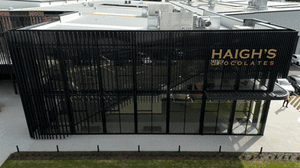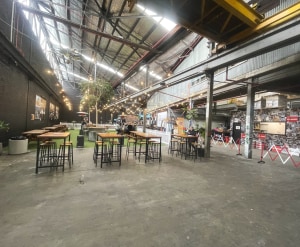Interest in the sustainability of labels and the printing and converting processes that produce them is clearly high, judging by the well attended webinar on the topic hosted yesterday by the Australian Institute of Packaging (AIP).
Over 150 participants from around the globe tuned in to discover more about 'Sustainable Label Materials, Inks & Coatings and Machinery used in Printing' and the current state of play in Australia and New Zealand.
Industry experts Michael Dossor, MAIP group general manager, Result Group; Mark Daws, MAIP director – Labels & Packaging ANZ, Currie Group; and Brad Wheeler, ANZ technical manager, DIC Australia presented their insights and expertise on their respective areas of speciality.
Dossor kicked off by discussing the APCO waste hierarchy and provided examples of how the 5Rs (reuse, reduce, renew, recycle, redesign) can be achieved in the industry, and honed in on the opportunity to reduce packaging using linerless labels.

Benefits of linerless labels, Dossor said, include zero liner waste to landfill, reduction in material usage, reduction in carbon emissions in label production, and saving on shipping, storage and production costs.
He noted there has been a strong uptake of linerless labels in the protein market (for example on fresh meat packaging), and to a growing extent in fresh produce.
Looking at the move to reuse or renew self-adhesive label liner waste, Dossor spoke of current schemes to convert glassine liner waste into insulation material for building, and recycling backing liner into paper-pulp to create paper products, including more backing liner.
On the subject of renewable materials in labels, he gave examples of facestocks comprised of rPE and rPP, facestock made from recycled paper, and cited a wine label on the Australian market made from 30 per cent grass content.
In terms of packaging sustainability that could be achieved via labelling, Dossor highlighted the evolution of compostable labels used for traditional, thermal and fresh produce labelling but cautioned that mandates are in place offshore regarding sustainability certifications for fruit labelling, and are deadlined for January 2022.
He said that a big issue to be taken into account was the compatibility of a label with the recycling system.
“If we can get the label off the product, we can increase the value of the recycled product and sell the base material,” he said, anticipating that there will be a lot of work in this space in the future.
“This market has the potential to evolve rapidly but will require collaboration between brand owner, material supplier and printer; and ultimately the recycling industry. If we get it right, we can gain local benefits and achieve our sustainability objectives very quickly,” he advised.
According to Dossor, another label product swiftly gaining momentum in markets outside of Australia, and starting up locally, is the wash off adhesive, widely used on fresh produce crates which often contain labels that won’t wash off.
In closing, Dossor said that “simple design changes amount to major benefits” and left attendees with three points to ponder – (1) the importance of matching the label stock to the application substrate; (2) label separation and recycling improves the purity of the recycling material; and (3) increased efficiency in recycling can ultimately reduce costs of recycled content materials.
PRINTING TECHNOLOGY
Mark Daws' discussion examined the factors and drivers that determine sustainability, outlined materials and technology currently available, and explored opportunities for printers and converters to grow and educate themselves in the sustainability arena.
Commencing his session by highlighting the benefits of sustainability for people, profit and planet, he went on to summarise the key drivers of consumers, brands and governments that are currently increasing demand for sustainable packaging. he noted that these drivers of sustainable packaging are pushing converters to provide solutions for their customers, and that demanding requirements and new legislation forces print service providers to embrace this change or be left behind.
After elaborating on the factors that determine the sustainability of a package, Daws highlighted various sustainable solutions on offer in the printing and technology arena. These included advancements in inks (water-based and UV curable), servo driven technology (for automatic colour registration pressure control) to reduce printing waste, and hot drying systems for energy efficiency.

The benefits of flexographic printing machines that can better handle thinner, more sustainable materials was also highlighted, with Daws pointing out the importance of digital printing in almost every label converter’s business.
According to Daws, digital printing offers tremendous benefits from an environmental standpoint, as it phases out big print runs from the supply chain and provides users with the ability to print on demand and do quick revisions.
“In terms of its actual production, [digital printing] doesn't require huge amounts of tooling plates, cylinders, or prepress capability technology. It’s very, very quick, provides electronic file to output and the final preparation involves zero waste,” he said.
With regard to the benefits of digital printing on transportation costs, Daws said that there is an increasing number of major global brand owners using digital technology for their label printing, which allows them to print consistent products of the same quality in various locations around the world, rather than one central point, saving the costs of shipping to various locations.
Moving on to pose the question as to what converters can do to play a role in the sustainability space, Daws discussed Currie Group’s work with Close the Loop, which was first introduced in Australia and NZ in 2019 but is now worldwide. The initiative offers sustainable recovery solutions to customers using HP Indigo digital presses, helping to lower the environmental impact of commercial printing and minimise the waste of ink and toners that end up in landfill.
Daws related that through Close the Loop, up until the third quarter of this year, over 61 tonnes of landfill was recovered.
On a final note, Daws suggested that improved industry collaboration for all parts of the supply chain would be beneficial, going forward.
“I think we need to really define some easy to read literature to help our customers. A lot of small to medium label printing business systems simply don't have the time or the resources to navigate their way through what can be quite onerous information, and we need to help them in some shape or form,” he said.
INKS & COATINGS
Brad Wheeler's session focused on the considerations involved by DIC Australia in shifting from a linear (take-make-dispose) to a circular economy model (make-use-recycle) via the operations and products involved in carrying out the 5R sustainabilty framework. Within this context, he discussed the implications of life cycle analysis, packaging costs, food safety and policy.
Wheeler elaborated on DIC's operations within the 5R sustainabilty framework, confirming that energy recovery was being made from waste, waste was minimised, energy and emissions reduced, energy renewable tactics employed, solvent and raw material recovery systems underway, and automation processes optimised.

to the 5R framework
He then took attendees through a series of slides, detailing the many ways in which DIC's products adhered to the 5R framework. For example, the company's continued and increasing use of recycled materials products (reuse); methods enabling customers to use less energy or materials (reduce); moving from fossil-based to increasing levels of plant-based raw materials from sustainable farm sources (renew); de-inking paper and plastics (recover) and looking at ways of matching solvent-based technologies more efficiently (redesign).
The chat room lit up with questions during the webinar, but time ran out for Q&A, so the AIP has undertaken to follow up with answers to the questions.
Given the high level of interest and audience engagement, it's likely that this topic will become a regular on the AIP education calendar.






